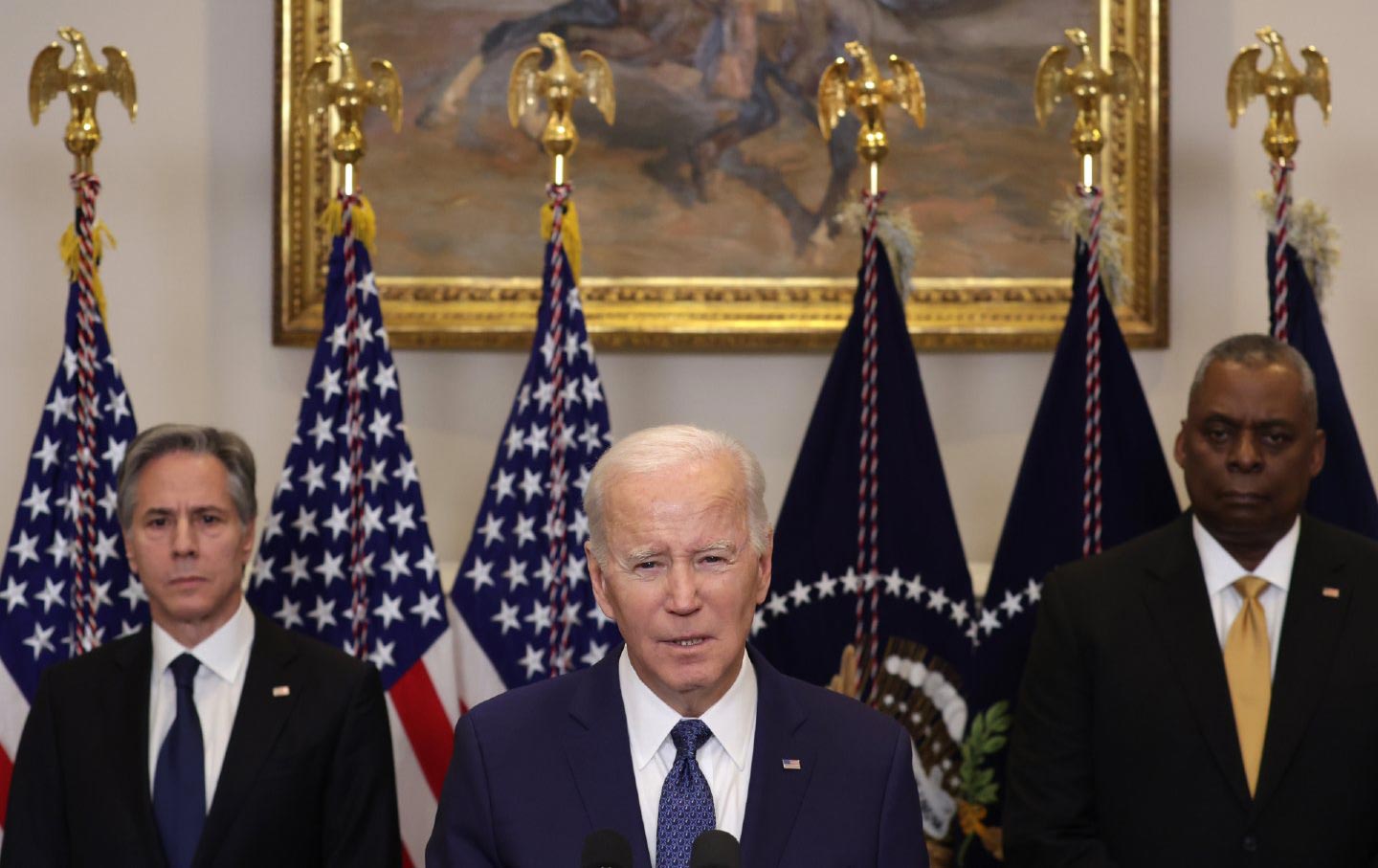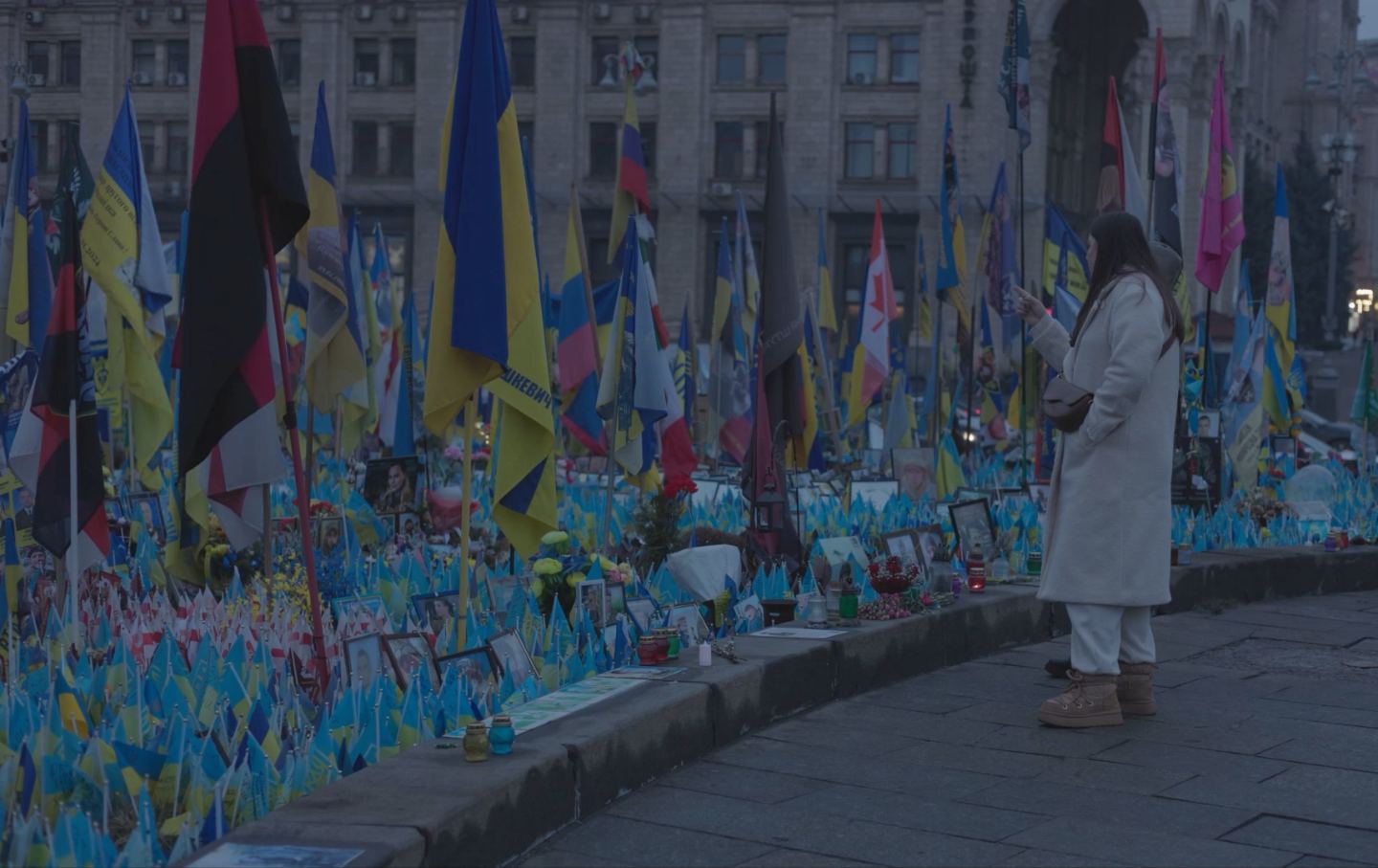We Should Pay Attention to the Ongoing Combat on the Red Sea
What we might call the Battle of the Tihamah has already lasted seven months and, surprisingly enough, given the opponents, its outcome remains in doubt.

Yemenis drive past a billboard depicting the navy destroyers of foreign countries, including the US and the UK, and the words “Navy coalition will be defeated” on a street in Sana’a, Yemen, on December 31, 2023.
(Mohammed Hamoud / Getty Images
This article originally appeared at TomDispatch.com. To stay on top of important articles like these, sign up to receive the latest updates from TomDispatch.com.
In mid-June, the Associated Press announced that the US Navy had been engaged in the most intense naval combat since the end of World War II, which surely would come as a surprise to most Americans. This time, the fighting isn’t taking place in the Atlantic or Pacific Oceans but in the Red Sea and the adversary is Yemen’s—yes, Yemen’s!—Shiite party-militia, the Helpers of God (Ansar Allah), often known, thanks to their leading clan, as the Houthis. They are supporting the Palestinians of Gaza against the Israeli campaign of total war on that small enclave, while, in recent months, they have faced repeated air strikes from American planes and have responded by, among other things, attacking an American aircraft carrier and other ships off their coast. Their weapons of choice are rockets, drones, small boats rigged with explosives, and—a first!—anti-ship ballistic missiles with which they have targeted Red Sea shipping. The Houthis see the US Navy as part of the Israeli war effort.
The Gate of Lamentation
In a sense, it couldn’t be more remarkable, historically speaking. Modest numbers of Yemenis have managed to launch a challenge to the prevailing world order, despite being poor, weak, and brown, attributes that usually make people invisible to the American establishment. One all-too-modern asset the Houthis have is the emergence of micro-weaponry in our world—small drones and rockets that, at the moment, can’t be easily wiped out even by the sophisticated armaments of the US Navy.
Another is geographical. The Houthis command the Tihamah coastal plain, the eastern littoral of the Red Sea. It stretches from the Bab el-Mandeb Strait (the entry point to that sea from the Gulf of Aden and the Indian Ocean) to the Suez Canal, which connects the shipping in those waters to the Mediterranean, and so to Europe. The Bab el-Mandeb, known for being treacherous to navigate even in the most peaceable of times, is said to mean “the Gate of Lamentation,” and these days, it’s living up to its name. Keep in mind that 10 percent of world seaborne trade flows through the Suez Canal and, perhaps even more importantly, 12 percent of the world’s energy supplies.
What we might call the Battle of the Tihamah has already lasted seven months and, surprisingly enough, given the opponents, its outcome remains in doubt. The Associated Press quotes Brian Clark, a senior fellow at the neoconservative Hudson Institute and a former Navy submariner, as expressing concerns that the Houthis are on the verge of penetrating American naval defenses with their missiles, raising the possibility that they could inflict significant damage on a US destroyer or even an aircraft carrier. Repeated American and British air strikes against suspected Houthi weapons sites in and around the Yemeni capital, Sanaa, have so far failed to halt the war on shipping. Even high-tech American Reaper drones are no longer assured of dominating Middle Eastern airspace since the Houthis have shot down four of those $30 million weapons so far.
Idling the Suez Canal
Given how little Americans generally know about Yemen, some historical background is perhaps in order. The Houthi movement has its roots in Zaydi Shiism, which took hold in northern Yemen in the 890s. (Yes, the 890s, not the 1890s!). Today’s Zaydis are upset by Israeli atrocities in Gaza. Last December, large crowds of them came out in the Zaydi stronghold of Saadeh and other northern Yemeni towns to protest Israel’s intensive bombing of that 25-mile strip of land. Waving Yemeni and Palestinian flags, they pledged support against “the armies of tyranny,” shouting, “We closed Bab el-Mandeb, O Zionist, do not approach!” and “The Yemeni response is legitimate, and the Red Sea is forbidden!”
The Houthis have indeed struck commercial container ships in the Red Sea, even seizing one, the Galaxy Leader (which, believe it or not, they turned into a tourist attraction). They also sank two cargo ships, killing three crew members. Although they maintain that they are only hitting Israeli-owned vessels, most of their attacks have, in fact, targeted the vessels of unrelated third parties like Greece. Their strikes have, however, caused a major disruption in world trade.
The Houthis have also fired large numbers of ballistic missiles at the Israeli Red Sea port of Eilat, idling it since November. Some 5 percent of Israel’s imports once arrived through Eilat. Now, such trade has been rerouted to Mediterranean ports at a distinctly higher cost, while southern Israel’s economy has taken a big hit. Gideon Golber, the CEO of the Port of Eilat, demanded that the United States intervene. And Israel is anything but the only country to suffer from such attacks. Ports such as Massawa, Port Sudan, and Berbera in the Horn of Africa have also become ghost towns, while the traffic through the Suez Canal is now so light that Egypt, which collects transit tolls, is suffering significant economic damage.
In addition, those Houthi strikes, local as they may seem, have had an impact on global supply chains. Insurance costs have risen radically, with crushing war-risk premiums. Ocean container ship rates surged this spring, as companies involved in the trade between Asia and Europe have been forced to avoid the Suez Canal and instead take a far longer route around the Cape of Good Hope and up the Atlantic coast of Africa. Shanghai to Rotterdam rates skyrocketed from $1,452 for a 40-foot container in July of last year to $5,270 in late May 2024.
Revolutionary Shiite Islam
The present militia commander in Yemen, Abdul-Malik al-Houthi, considers himself part of a Shiite revolutionary tradition that goes back a long, long way. So, to truly grasp the dangers of the moment for the US Navy in the Red Sea, it makes sense, believe it or not, to momentarily journey deep into history.
Last year, al-Houthi observed the death in battle of the founder of his tradition, Zayd Ibn Ali, in the year 740. His “movement, renaissance, jihad, and martyrdom,” he said, “made a great contribution to the continuity of the authentic Islam of Muhammad.… He faced tyranny and had an impact on instituting change.”
A generation of Americans involved in the Middle East has come to understand that there are two major branches of Islam, the Shiites and the Sunnis. Neither is monolithic, with each branch having several denominations. The division between the two goes back to questions about the succession to the prophet Muhammad (who died in 632). One faction of early believers invested leadership in senior disciples of the prophet from his Quraysh clan. Over the centuries, these became the Sunnis.
Another faction, which gradually evolved into the Shiites, favored Muhammad’s son-in-law and first cousin, Ali ibn Abi Talib. Seeking a dynastic succession, they invested leadership in Ali’s descendants through the prophet’s daughter Fatimah. Most Shiites historically acknowledge 12 imams or leaders of the dynasty. The Zaydis, however, accepted only five early imams.
Popular
“swipe left below to view more authors”Swipe →Unlike the Shiites of Iran and Iraq, Yemen’s Zaydis never had ayatollahs. Nor did they curse Sunnis, with whom they often had good relations. The Zaydi branch of Shiism in Yemen was led by court judges or qadis, typically hailing from a caste of putative descendants of the Prophet Muhammad, the Sayyids or Sadah, who emerged as mediators in tribal feuds. Critics of today’s Helpers of God government in North Yemen allege that, despite its populist rhetoric, it is dominated by a handful of clans who consider themselves descendants of the prophet, including the Houthis themselves.
Saudi Hegemony and the Rise of the Houthis
Forms of Arab nationalism and a rhetoric of anti-imperialism are anything but new in Yemen. After World War II, with European empires weakened, a desire for independence swept the Global South. Colonel Gamal Abdel Nasser of Egypt emerged as the nationalist leader who finally kicked the British out of his country, inspiring so many others in the region. Egyptian-backed young officers in Yemen’s capital, Sanaa, staged a coup in 1962 against a hidebound theocratic leader who had long kept the country in a state of isolation. In the process, they drew it into a civil war between republican nationalists and royalists. Britain, Saudi Arabia, and Israel all backed the royalists, but some 100,000 crack Egyptian troops won the day for the young officers before withdrawing in 1970.
In 1978, Colonel Ali Abdallah Saleh, a politician in North Yemen, launched an internal coup within the officer corps there and appointed himself president for life. His corrupt government, putatively a secular Arab nationalist one, would receive billions of dollars from the fundamentalist royalists of Saudi Arabia.
The Helpers of God party militia, or the Houthis, arose among the Zaydi Shiites of northern Yemen in the 1990s as a backlash against the inroads that neighboring, wealthy Wahhabi Saudi Arabia had made. That country’s Wahhabism had arisen as a puritan reform of Sunnism in the eighteenth century. Saleh allowed its missionaries to proselytize the Shiite Zaydis, provoking the anger of the latter.
Under the influence of the anti-Saudi Houthi family, Zaydi militiamen based in Saadeh in Yemen’s hardscrabble north turned radical, coming into frequent conflict with the Yemeni army. When the Arab Spring youth revolt overthrew Saleh in 2012, the Houthis’ political wing sought influence in the new government. But in September 2014, impatient with an interminable reform process aimed at drafting a new constitution and electing a new parliament, the Houthis marched into the capital, Sanaa, and took it over. Behind the scenes, they had allied with the deposed president, Saleh, before his death, and the army faction still loyal to him, which gave them access to billions of dollars in American-supplied weaponry. By early 2015, the Houthis had expelled Saleh’s successor, Abdrabbuh Mansur Hadi, from the capital and made an unsuccessful bid to take over all of Yemen from Saadeh in the north to Aden in the south.
Meanwhile, their dominance of North Yemen proved unacceptable to the Saudis and the allied United Arab Emirates (UAE), whose secular potentate, Mohammed Bin Zayed, had long despised such Islamic political movements. As a result, those two countries launched an air war against the Helpers of God in the spring of 2015. The ruinous Seven Years War that followed would displace millions and endanger even more millions with food insecurity and disease. It failed, however, to dislodge the Helpers of God and, by 2022, a truce was finally agreed to. Perhaps thanks to that painful experience, the Saudis have declined to join the Americans this year in the Battle of Tihamah. And in some fashion, the Houthis’ experience of the intensive aerial bombing tactics of Saudi Arabia and the UAE years ago undoubtedly left them with particular sympathy for the Palestinians under incessant Israeli air assault in Gaza.
An Alliance of Resistance
Both the Saudis and the Emiratis saw the Houthis as a mere cat’s paw for Iran. Although the Iranians did indeed offer them some support, this was a distinct misreading of the relationship between Sanaa and Tehran. At the very least, Iranian aid was dwarfed by the billions of dollars in weaponry Washington provided to Riyadh and Abu Dhabi in those years.
In reality, the Houthis are homegrown Yemeni nationalists, having even attracted some Sunni tribes into their coalition. Still, their current leader, Abdul-Malik al-Houthi, has clearly been influenced by aspects of Iran’s political radicalism and chants “death to America” and “death to Israel” just the way Iran’s clerical leader Ali Khamenei does. Like the regime in Iran, the Houthi government has no respect for domestic human rights or dissent. Although there is no command line from Tehran to Sanaa, the Houthis do loosely form part of Iran’s “alliance of resistance” against Israel and the United States. However, it’s not clear that Iran, closely allied with Russia and China and covertly exporting its US-sanctioned petroleum to China, ever wanted international shipping costs to double, thanks to the Houthi attacks in the Red Sea, something which hurts all three of those countries.
Despite the Houthi appeal to religious identity, it’s also mainly a movement of Arab nationalists, which helps to explain its deep sympathy for the Sunni Palestinians as fellow Arabs. In an interview at the beginning of June, Houthi leader Abdul-Malik al-Houthi condemned Israel for its genocide against the Palestinian people in Gaza and its targeting of the West Bank and Palestinian East Jerusalem. He similarly denounced Washington as an imperial partner of Israel and an enabler of its crimes, as well as a hypocrite in theoretically promoting respect for the rule of law, while dismissing or even threatening international courts and supporting crackdowns at American colleges and universities when their students protested Israeli policies. He also praised the resistance of the vaguely allied forces of Lebanon’s Hezbollah and Iraq’s Shiite militias. In the process, he vowed that however intense American (and British) air attacks on Yemen became, he and his movement would never back down from their support of the Palestinian people.
At the moment, the situation in the Red Sea remains militarily muted, but it has the potential to become one of the most dangerous in the world, rivaling those in Ukraine and Taiwan. In the meantime, it remains a drag on the global economy, while helping to contribute to stubborn inflation and supply-chain problems.
Significant Houthi damage to a US naval vessel at any point in the future could plunge Washington into warlike acts that might risk direct conflict with Iran. President Joe Biden could, of course, lower the temperature by moving far more strongly to end Israel’s total war on Gaza, an intolerable affront to norms of international humanitarian law that only strengthens the vigilantism of the Houthis and their like. While the ongoing Israeli assault should be ended to prevent further death and looming mass starvation in Gaza, it should also be ended to forestall yet another ruinous American war in the Middle East.
Support independent journalism that exposes oligarchs and profiteers
Donald Trump’s cruel and chaotic second term is just getting started. In his first month back in office, Trump and his lackey Elon Musk (or is it the other way around?) have proven that nothing is safe from sacrifice at the altar of unchecked power and riches.
Only robust independent journalism can cut through the noise and offer clear-eyed reporting and analysis based on principle and conscience. That’s what The Nation has done for 160 years and that’s what we’re doing now.
Our independent journalism doesn’t allow injustice to go unnoticed or unchallenged—nor will we abandon hope for a better world. Our writers, editors, and fact-checkers are working relentlessly to keep you informed and empowered when so much of the media fails to do so out of credulity, fear, or fealty.
The Nation has seen unprecedented times before. We draw strength and guidance from our history of principled progressive journalism in times of crisis, and we are committed to continuing this legacy today.
We’re aiming to raise $25,000 during our Spring Fundraising Campaign to ensure that we have the resources to expose the oligarchs and profiteers attempting to loot our republic. Stand for bold independent journalism and donate to support The Nation today.
Onward,
Katrina vanden Heuvel
Editorial Director and Publisher, The Nation
More from The Nation

Going for Green: Uruguay’s Renewable Energy Revolution Going for Green: Uruguay’s Renewable Energy Revolution
With no fossil fuel reserves to rely on and domestic demand rising, the country had to get creative—or go broke just trying to keep the lights on. Here’s how they did it.

Andrée Blouin’s Revolutionary Lives Andrée Blouin’s Revolutionary Lives
The African political leader’s autobiography, My Country, Africa, also offers a larger story of empire, oppression, and resistance on the continent.

Life in Cuba Under Sanctions Life in Cuba Under Sanctions
Ordinary Cubans are trapped in a vicious circle of government mismanagement exacerbated by the US embargo.

The Crisis Engulfing the French Left The Crisis Engulfing the French Left
The New Popular Front alliance looked like the best hope the left had against Macron and Le Pen. But after months of internal conflicts, it’s on the brink of collapse.

Why We Asked the ICC to Investigate Biden for Aiding and Abetting Genocide Why We Asked the ICC to Investigate Biden for Aiding and Abetting Genocide
The evidence that Joe Biden, Antony Blinken, and Lloyd Austin helped Israel commit war crimes is overwhelming.

“We’re On Our Own”: Ukrainians Confront a New Reality “We’re On Our Own”: Ukrainians Confront a New Reality
Even leftists who disagree with some of Zelensky’s policies are glad he didn’t back down to Trump.


